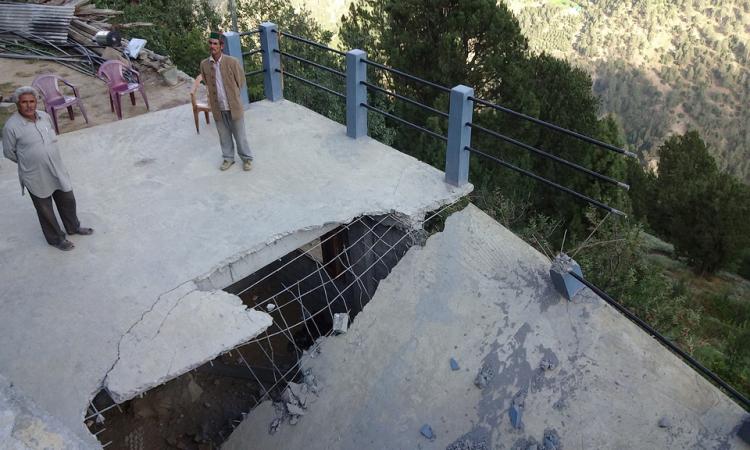
Around 21 major hydropower projects are proposed in the upper Satluj catchment area of Himachal Pradesh. In 2013, The Environics Trust collaborated with Himalaya Niti Abhiyan to assess the impact of these projects on the people and ecology of the geographically-fragile Kinnaur region. We talk to R Sreedhar of Environics Trust about the findings of the study and future course of action.
What are the main points of your study on hydropower projects in the upper Satluj basin ?
The key issues the report is highlighting are as follows:
- Rivers should be studied and activities planned in a holistic manner considering the entire basin with a participatory approach seeking explicit inputs from local communities.
- Himalayan river systems are unique and changes in the upper watersheds will have major ramifications downstream.
- Himalayas are extremely vulnerable to earthquakes and other natural calamities and construction of hydropower projects adds to their vulnerability.
- The system of analysis and promotion of projects and their appraisal is neither scientific nor ethical.
- Governments and corporates are going for increasing their revenue and profits at a huge risk to the communities.
Governments and developers often term run-of-river pojects as comparatively benign. What has been the experience in Kinnaur?
It is a farce. Any intervention in the river system is harmful. Since there has been huge amounts of evidence and global outcry against large dams which submerge huge tracts of land and displace people, run-of-river projects are being touted as benign. The impacts caused are overlooked and promotional assessments are being made and accepted by the state.
Seismic activity and weather variability are two major factors mostly sighted to underscore the vulnerability of Kinnaur and the non-feasibility of hydel projects but that also raises a question as to why developers are willing to risk their investments, doesn't it?
Where is the risk of investment? If you listen to the RBI Governor’s speeches, these are public monies. Look at Jaypee Group – they got the State to resort to violence, got their project established and walked away selling it with nearly a billion dollar profit! It is by now common understanding that most promoters in India pad up initial costs, get loans and skim-off the money.
How has the work on compensation and rehabilitation of people and ecological restoration progressed for projects already in operation or construction?
Compensation is so little that sometimes I feel it is a pittance for the sustenance. Ecological restoration is only on paper and in fact very difficult to achieve even with sincere efforts. CAG has been indicting the Catchment Area Treatment Plans in various projects periodically but unless taken to court and monitored, companies get away with little work.
What has been the response of people from Kinnaur to the projects? Would you say it's mixed as many may see them as harbingers of 'development', or have they now understood the harmful ecological and social impacts?
Initially like all innocent rural people, the people of Kinnaur got carried away by the propaganda of the developers and the State. As projects came up and they witnessed the harmful impacts, people became aware and are now making all efforts to stop further destruction.
How do you think out migration from Kinnaur alters local aspirations and connection with ecology?
While there is outmigration, Kinnaur is among the rare regions where people come back to take up horticulture. It is rare to see retired people staying outside of Kinnaur. Therefore the connect with the ecosystems has not been lost.
How have the government and private developers reacted to this report?
There has been no official reaction. Perhaps when it is placed before the National Green Tribunal they will counter it.
Department of Energy (DoE), Government of Himachal Pradesh (GoHP) has also done the Cumulative Environmental Impact Assessment (CEIA) Study of Hydropower Projects in the Sutlej basin. How is it different from your report?
It is a highly expensive report without any insights. The governments--State and Central--are saying that they have not accepted the report and hence it is still a draft. What is surprising is that the consultants have a contorted view of what is a cumulative impact. We are asking for understanding the synergetic impacts such as a worst case scenario – earthquake trigger in upper reaches causing avalanches leading to flash flood, dam burst and massive flooding downstream. Are we prepared to deal with that if we overlook the need for understanding?
What is your next plan of action?
We will continue to collaborate and support the local communities with scientific and technical information and challenge faulty environmental assessments being made.
This report talks about the upper Satluj basin. Are you planning to cover the whole basin subsequently?
Yes, we plan to study the next segment till the Koll Dam site this year and integrate it with the current study. Post that, we will study the Bhakra dam and its downstream areas till the border of the country to generate a more comprehensive understanding of the river system, the environmental and social aspects.
See the full study report.